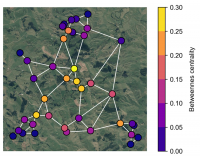Kararehe Kino - Animal Pest Research Issue 32

This issue of Kararehe Kino presents a sample of quantitative modelling methods and how they can be applied to various wildlife management issues.
Kararehe Kino is also available in print. Please email the editor, Morgan Coleman colemanm@landcareresearch.co.nz, if you would like to receive printed copies of this newsletter.
In this issue

Editorial: Using quantitative models to gain insights in ecology
It is probably a fair assumption that people who are interested in the life sciences are not secretly yearning to learn and apply quantitative methods. Indeed, for many professional ecologists, mathematics and statistics were their least favoured subject areas during their training. However, because ecology typically involves trying to make sense of a complex system, we often require quantitative models to help us in that endeavour.

Prioritising pest control based on network connectivity
Resources for the control of invasive pests can be prioritised for certain sites in different ways, but one approach that has not received a lot of attention is prioritising sites based on landscape connectivity.

Ecology, economics and ethics: the three Es required for sustained and effective vertebrate pest management
In New Zealand some introduced vertebrates are managed to limit their impacts on indigenous biodiversity, agricultural production, and infrastructure, and others for commercial and recreational harvest. Most of this management requires the use of lethal tools and techniques, and as a result wildlife managers are often challenged to justify their policies and actions on the basis of pest ecology, population dynamics and ethical acceptability.

Using computer models to understand and forecast reinvasion by invasive mammals
Preventing and effectively managing reinvasions is essential for the long-term viability and success of invasive species eradication and control interventions. It is a particularly formidable challenge in mainland scenarios where there are no natural barriers to hamper the spread and movement of potential reinvaders.

Modelling supports nimble predator management for increasing kiwi populations over large areas
The recovery of the five species of kiwi is a national conservation priority. The great spotted kiwi, tokoeka and brown kiwi live in large tracts of forest and are experiencing population declines due to invasive predators. While the little spotted kiwi and rowi have low populations, their numbers locally have stabilised or are increasing due to effective predator management.

Wielding power for pest control
Consider this scenario: introduced predators, like ship rats, are responsible for dwindling numbers of North Island robins at Hamburger Hill Scenic Reserve. An aerial poison operation reduces rat numbers by an estimated 95%, and managers want to determine the response of the robin population to reduced predation.

Using surveillance models to provide confidence in the eradication of Argentine ants
Surveys undertaken near the end of an eradication programme will often not find any target pests and the search results will consist of many zeros. But how do we know those zeros are real and there really are no pests left? Maybe some individuals have survived control but haven’t been detected because they are so rare, and/or the search effort was insufficient to find them.

How do behavioural differences in pests affect their trapability and eradication success?
New Zealand has a history of successful small mammal eradications from offshore islands. On the mainland, advances in pest-proof fencing technologies have made it possible to eradicate pests over relatively small areas and to protect against reinvasion. Since the announcement of the Predator Free 2050 goal in 2016 there has been increased interest in the development of new tools and strategies to improve the efficiency, effectiveness and scale of pest eradication operations.

TrapSim: an online tool to help managers decide on a trapping regime
When faced with the task of managing predators at a landscape scale, there are a number of decisions land manager(s) must make. These include how many traps should be used, how far apart traps should be set, how often traps should be checked, and are traps needed that can catch/kill more than one animal before being reset?

Economic aspects of New Zealand’s wild deer recovery industry
Red deer were introduced into New Zealand in the mid to late 1800s and are now almost ubiquitous across both the North and South Islands. The commercial recovery and export of venison from wild-caught deer began in about 1958, but the industry did not grow significantly until about 1963, when helicopters were first used to harvest deer carcasses from alpine grasslands.


